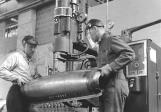22
The undercarriage of the Mosquito was simplicity itself. It was deliberately designed to avoid as much machining as possible. The undercarriage legs were completely interchangeable, consisting of nothing more than stamped metal housings containing a stack of rubber blocks. The large low pressure tires helped to absorb some of the shock. This no maintenance system worked well, and was still being used on the Twin Otter some decades later with Neoprene blocks.By contrast, the German Moskito had an unnecessarily complex undercarriage that was prone to failure. The Ta 154 was fast enough while unarmed to catch a de Havilland Mosquito, but fully equipped was not good enough. It lacked the same "stretch", or potential for development. Focke Wulf engineers complained that they could not get their wing smooth enough.
The early Mosquito was not without its difficulties though. The original short engine nacelles caused tailplane buffeting because of disturbed air flow. The tail wheel was a weak point in the design that was never adequately resolved, and the exhaust system was troublesome to the end. Nevertheless, de Havilland produced a winner because they had the patience and gumption to address the inevitable development problems.







